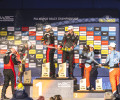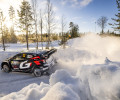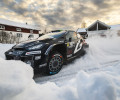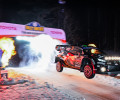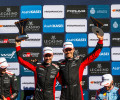WRC - Rallye d'Espagne - Aperçu (en anglais)
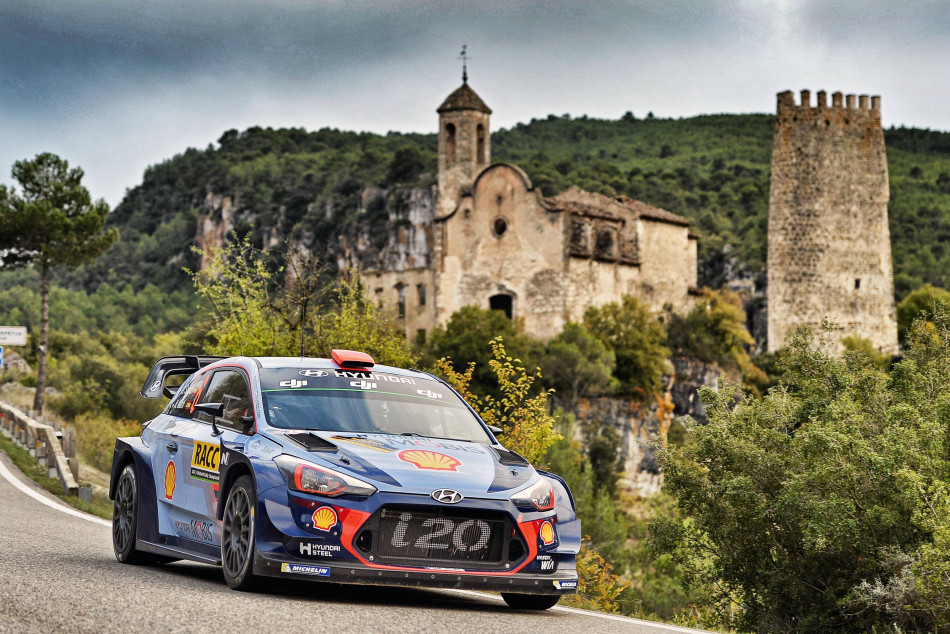
The penultimate round of the FIA World Rally Championship, Rally de España (25-28 October), is unique in being the only mixed surface event on the calendar, combining one day of primarily gravel stages with two solely on tarmac. After the first full day on Friday teams need to convert their cars from gravel to asphalt specification in a longer than usual final service, and drivers then need to adapt overnight to the fast and smooth roads that require a much more precise style of driving. The event has a long history dating back to 1957 and was first included in the FIA European Rally Championship in 1975. It graduated to WRC status in 1991 when it was based on the Costa Brava and the then all-asphalt rally relocated to Salou in 2002. It only changed to a mixed surface event in 2010, creating a very different challenge on the WRC calendar. After numerous dramatic twists and turns on recent events, which has resulted in the Championship fight being the most intense in years, Thierry Neuville continues to head the standings but the Belgian’s advantage has been cut to seven points over multiple champion Sébastien Ogier. After his remarkable victory in Wales two weeks ago, the Frenchman is now back ahead of Ott Tänak, the Estonian’s run of three consecutive victories coming to a disappointing end in the Welsh forests. He is a further 14 points behind Ogier as the three-way title fight continues in Spain. Nine-time FIA World Rally Champion Sébastien Loeb also joins the stars of the show for the third of his planned outings in the Citroën C3 WRC, adding to what is already an eagerly-anticipated showdown on the Spanish stages. After a string of double podium results, Toyota heads the Manufacturers’ Championship by 20 points over Hyundai. Jan Kopecký continues to lead the FIA WRC 2 Championship and the stellar 21-car entry in the category is boosted by the debut appearance of two Volkswagen Polo GTI R5s in the hands of former FIA World Rally Champion and FIA World Rallycross Champion Petter Solberg, and Eric Camilli. Five stages will be broadcast live on television; SS1 on Thursday, SS10/13 on Saturday and both runs through Santa Marina (SS16/18), the latter being the all-important Power Stage. All stages are however available live on WRC All Live on the WRC+ platform. ROUTE GRAPHICS
The 2018 event kicks off with the welcome return of the spectacular street stage in the Montjuïc area of Barcelona on Thursday evening before returning to the tourist resort of Salou for the overnight halt. Friday crews head west for the longest day of the event. Two identical loops of three gravel stages await, two not used since 2014 and the 38.85 kilometres of La Fatarella-Vilalba also including some asphalt sections. After swapping the cars to asphalt specification overnight, Saturday and Sunday are contested purely on tarmac. Saturday’s route heads north-east and is rounded off with a street stage on the Salou seafront, while Sunday’s two loops of two stages are also similar to last year. RALLY DATA
MEDIA ACCREDITATION
RALLY DE ESPAÑA TIMETABLE AND MEDIA OPPORTUNITIES ORGANISED BY THE FIA
FIA PRESS CONFERENCE ATTENDANCE
MANUFACTURER ENTRIES, RALLY DE ESPAÑA
ADDITIONAL MEDIA OPPORTUNITIES The provisional classifications for all the WRC Championships can be found on the following link: www.fia.com/events/world-rally-championship/season-2018/standings Shortly after the finish of the event, a downloadable stage chart showing the progressive positions of the leading crews during the rally will be available. This is copyright free for editorial purposes and available at the following link: www.fia.com/events/world-rally-championship/season-2018/stage-chart-10
L’avant-dernière manche du Championnat du Monde des Rallyes de la FIA, le Rallye d’Espagne (25-28 octobre), est unique en son genre puisqu’il est la seule épreuve du calendrier courue sur surface mixte, combinant une journée de spéciales principalement sur terre et deux intégralement sur asphalte. Après la première journée complète du vendredi, les équipes devront transformer les voitures d’une spécification terre à une spécification asphalte lors d’une assistance plus longue qu’à l’habitude, et les pilotes devront alors s’adapter en une nuit aux routes rapides et fluides qui exigent un style de pilotage bien plus précis. L’épreuve a été courue pour la première fois en 1957, puis a rejoint le Championnat d’Europe des Rallyes de la FIA en 1975. Alors basée sur la Costa Brava, elle a intégré le WRC en 1991 et le rallye tout asphalte a ensuite été déplacé à Salou en 2002. Elle n’est devenue une épreuve sur surface mixte qu’en 2010, créant un challenge très différent dans le calendrier WRC. Après de nombreux rebondissements spectaculaires lors des dernières manches, faisant de la lutte pour le titre l’une des plus intenses observées depuis des années, Thierry Neuville demeure en tête du classement mais son avantage sur le multiple champion Sébastien Ogier a été réduit à sept points. Fort d’une victoire remarquable au Pays de Galles il y a deux semaines, le Français est à présent de retour devant Ott Tänak, la série de trois victoires consécutives de l’Estonien s’étant terminée de manière décevante dans les forêts galloises. Il a encore 14 points de retard sur Ogier tandis que la bataille pour le titre à trois se poursuit en Espagne. Sébastien Loeb, neuf fois Champion du Monde des Rallyes de la FIA, rejoindra ces grands noms pour sa troisième participation à bord d’une Citroën C3 WRC, venant agrémenter ce qui est déjà un rendez-vous très attendu dans le pays. Après une série de doublés, Toyota prend la tête du Championnat Constructeurs avec 20 points d’avance sur Hyundai. Jan Kopecký demeure en tête du Championnat FIA WRC 2. Deux Volkswagen Polo GTI R5 feront leur première apparition aux côtés des 21 voitures engagées dans la catégorie, pilotées par Petter Solberg, ancien Champion du Monde des Rallyes de la FIA, et Eric Camilli, Champion du Monde de Rallycross de la FIA. Cinq spéciales seront diffusées en direct à la télévision : l’ES 1 le jeudi, l’ES 10/13 le samedi et les deux passages sur Santa Marina (ES 16/18), le dernier faisant office de Power Stage. Toutes les spéciales seront diffusées en direct sur WRC All Live sur la plateforme WRC+. ITINERAIRE
L’édition de 2018 voit le grand retour de la spectaculaire spéciale courue en ville jeudi soir dans le quartier de Montjuïc à Barcelone. Les équipages retourneront à la station touristique de Salou pour la nuit. Vendredi, la plus longue journée, les concurrents prendront la direction de l’ouest. Deux boucles identiques de trois spéciales terre figurent au programme, deux non empruntées depuis 2014 ainsi que la spéciale de La Fatarella-Vilalba, longue de 38,85 kilomètres, avec également quelques sections sur asphalte. Après une transformation des voitures durant la nuit pour les adapter aux spécifications asphalte, les journées de samedi et dimanche seront disputées uniquement sur asphalte. Samedi, les équipages mettront le cap vers le nord-est et le parcours se terminera par une spéciale en ville sur le front de mer de Salou, tandis que les deux boucles de deux spéciales du dimanche sont semblables à celles de l’année dernière. DONNEES CONCERNANT LE RALLYE
ACCREDITATION MEDIAS
PROGRAMME DU RALLY DE ESPAÑA ET OPPORTUNITES POUR LES MEDIAS ORGANISEES PAR LA FIA
PARTICIPANTS AUX CONFERENCES DE PRESSE DE LA FIA
ENGAGEMENTS CONSTRUCTEURS, RALLY DE ESPAÑA
OPPORTUNITES SUPPLEMENTAIRES POUR LES MEDIAS Les classements provisoires du Championnat WRC sont accessibles en cliquant sur le lien suivant : www.fia.com/events/world-rally-championship/season-2018/standings GRAPHIQUE DES SPECIALES Peu après la conclusion du rallye, un graphique des spéciales téléchargeable montrant les positions progressives des équipages de tête pendant le rallye sera disponible. Celui-ci est libre de droits d’auteur à des fins éditoriales et est accessible en cliquant sur le lien ci-après : www.fia.com/events/world-rally-championship/season-2018/stage-chart-10 |



 Facebook
Facebook Twitter
Twitter